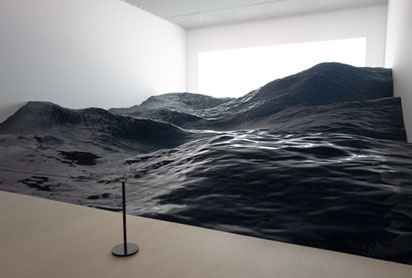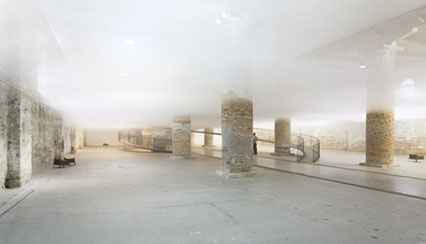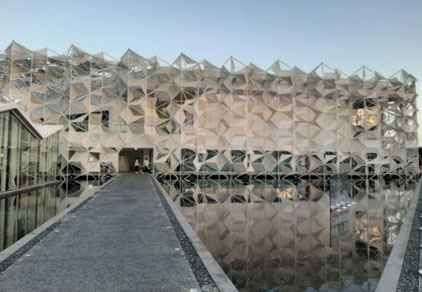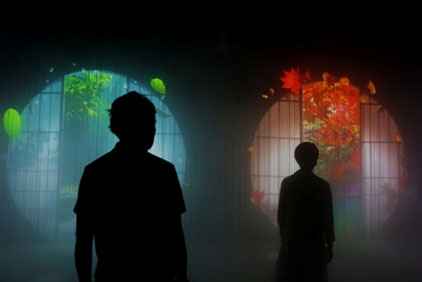Revised 19 April 2022
Accepted 14 October 2022
Available Online 21 November 2022
- DOI
- https://doi.org/10.55060/s.atssh.221107.004
- Keywords
- Contemporary museums of Japan
Latest exhibition projects
Architecture of sensory experience
Venice Biennale of Architecture
World exhibitions - Abstract
This article analyzes the latest approaches to the organization of exhibition spaces in contemporary Japan. The research reveals a certain tendency of inclusion of sensory experience and comprehension during a process of perception of an art museum or exhibition. This idea has become the key strategy for many modern concepts of museum and exhibition programs and, at the same time, it is the core of the entire Japanese culture, emerging in different forms from antiquity to the present day.
- Copyright
- © 2022 The Authors. Published by Athena International Publishing B.V.
- Open Access
- This is an open access article distributed under the CC BY-NC 4.0 license (https://creativecommons.org/licenses/by-nc/4.0/).
1. INTRODUCTION
This article continues the author's research on the formation of the latest approaches in architecture and artistic expressiveness in contemporary museums in Japan. In recent years, Japan has been searching for a new image of contemporary museums: there are discussions about their function and ways to organize exhibition space, and a significant number of conceptual experiments at the level of temporary exhibitions. Such temporary exhibition spaces created in Japan in recent years (both on the territory of existing museums and representing a full-fledged architectural and artistic experiment) are a unique experience in the development of principally new characteristics of art museums. All these experiments are carried out for the sake of expanding the scope of functions and semantic content of the art museum. Within the framework of this article, we highlight such characteristics of contemporary exhibition spaces in Japan that allow creating new generation of museum that actively interacts with its visitors.
The desire of contemporary Japanese architects to return sensory experience to architecture, through which a connection with the traditions of Japanese culture would be made, could not bypass such objects of art as museums. Building a connection with the traditions of one's own culture not directly, but on the level of subtle, often passing by consciousness, and more intuitive images and meanings, can be considered one of the most urgent aims of contemporary Japanese architects. A significant number of new museums or exhibition halls are not distinguished by the uniqueness of their collections or the presence of rare and valuable exhibits, but they allow you to create your own unique emotional, intellectual experience and encourage reflection, contemplation, and inner discoveries.
2. EXPERIMENTAL PROJECTS OF THE 目[MÉ] CONTEMPORARY ART TEAM
One of the most ambitious and innovative experiments in the field of contemporary museum display was the concept of the 目[mé] command, which was to allow a person to enjoy things that he or she does not understand. It is a subtle philosophical and psychological point which has never attracted much attention. It became the main issue of the exhibition under the provocative title “Obviously, no one can make heads nor tails” [1], which was held at the Chiba City Museum of Art in 2019. That exhibition has become one of the largest projects of the 目[mé] contemporary art team, which, thanks to its extraordinary works, attracted a lot of attention both at home and abroad. The creative team develops exhibition projects that appeal to the real feelings of people and tries to convey the facets of the colors of the surrounding world (its attractiveness, uncertainty, variability) through the sensations and personal experience of each person.
For the period of the exhibition, the entire building of the Chiba City Museum of Art was transformed into a large installation. The exhibits of that experimental exhibition included not only art as a form of reality, but also its projection in people's mind. According to the idea of the authors, the reaction of the audience, movement around the exhibition and manifestation of their feelings can also be seen as artistic performance. To implement this bold concept, the creators did not limit themselves to the museum space. They used and transformed the area around the museum, and in fact completely renewed the perception of the territory of the entire city or town, as if forcing visitors, i.e. participants of this program, to look through the prism of a concept at the world around them.
The central topic of the exhibition was the geological fault that runs through all the Japanese islands and its impact on people's lives. Periods of activity, strength of impact of the fault has not yet been fully elucidated by contemporary science, but it is undeniable that it turns Japan into one of the most earthquake-prone points on the globe. The Nojima Fault, for example, caused the Great Hanshin Earthquake of 1995 [2]. In Japan, even the Nojima Fault Preservation Museum has been created. For evident reasons, this topic is relevant in the country. In this case, at the exhibition “Obviously, no one can make heads nor tails”, the real world is presented as a series of natural disasters, which are impossible to accurately predict and to fully understand their causes (Fig. 1). The main idea is that each visit to the exhibition is a unique experience, formed both from a person's personal experiences and from objective changes in the real world between periods of activity of unpredictable natural anomalies.
Moreover, the exceptionally dynamic exhibition space was fundamentally different for various people, as they filled it with individual characteristics: meanings, images and emotions. People who visited the museum for that exhibition got an opportunity to see the real world in a new way, and perhaps to consider new meanings and landmarks that have been previously overlooked as something trivial. According to the general concept, each spectator could experience strong impressions and emotions from the exhibition, regardless of whether he or she understood it or not. “A good work of art is nothing more than something that touches the viewer's heart,” wrote art critic Noi Sabuki in his book ‘Sensibility Doesn't Impress’ [3].

A fragment of the exhibition “Obviously, no one can make heads nor tails”.
Previously, the 目[mé] team has already organized several exhibitions that literally break the traditional idea of the museum space. Particularly striking in this regard was the exhibition “Unreliable Reality — The Where of This World”, held at the Shiseido Gallery in Tokyo in 2014. It raised a question of relativity of any position of a physical body in the Universe and the mutual influence of those bodies in a vast space. At the same time, inspiration and imagination can help break all the laws of gravity, which the organizers tried to convey through artistic means.
According to the creative concept of the authors, each visitor got an opportunity to look at the ‘unreliable reality’ through the complex internal space created in the gallery. The individual perception, or rather, experience, exposes the physical sensations of the audience, forcing not only to consider, but also to feel emotionally all the relativity and variability of the world which is called the reality. When people start to look at their existence from such point of view, they are ready to perceive themselves and the meaning of their personality against the background of the Universe in a completely different way.
A conceptually similar exhibition experiment with the expansion of the space to the scale of the entire city was held at the Chigasaki City Art Museum. In 2019, the exhibition “Road to the Museum of Fine Arts” was opened there, which, in addition to the main exhibition, included installations and performances organized in various parts of the city. The opening of that exhibition was preceded by a ‘field study’. It was observed how residents from various parts of the city with physical disabilities, such as visually impaired people, wheelchair users, etc., passed the road to the museum. The study showed that they filled the space with their own, individual characteristics. On that basis, it was concluded that different people perceive the same spaces and define similar circumstances in a different way. In general, the exhibition consisted of works for the perception of which all the senses are needed — sight, hearing, touch, and smell. Therefore, each person, depending on individual characteristics of perception, filled specific impressions with various facets of feelings, emotions, and meanings.
3. EXPERIMENTAL PROJECT OF THE TETSUO KONDO “CLOUDSCAPES”
In recent years, Japanese architects actively created various types of exhibition spaces designed not only for personal experience of perception, but also for the interaction with visitors; they even change their characteristics depending on some alterations in people's behavior. A bright and bold experiment in that direction was presented at the XII Venice Biennale of Architecture in 2010. In an interview with ARTiT magazine, Kazuyo Sejima, one of the most influential female architects in Japan, talked about the relevancy of the chosen motto of this biennale: “People meet in architecture” for the contemporary world. According to Kazuyo Sejima, the time has come to discuss a new level of interaction between people and architecture, as well as relationships of people which can be revealed through architecture [4]. In many ways, it was a response of the professional community to the processes of globalization and attempts to oppose them with a new concept of the development of architecture.
One of the symbols of the chosen motto of the 2010 Venice Architecture Biennale was the Japanese exposition, which featured the work by a young Japanese architect Tetsuo Kondo ‘Cloudscapes’ (Fig. 2). He developed an experimental project with a cloud that creates a soft permeable space. When a person appears in this space, due to a change in temperature, it changes its characteristics. Visitors were invited to walk through the unusual space, which seemed to be akin to the usual experience of walking in a garden. The created path was a complex curve leading through cloudy landscapes that appeared and disappeared from view. Sometimes, people saw only other people through the cloud, while the path itself was hidden. The cloud was constantly changing, so the experience of the path was dynamic and individual for each person.
Besides the fact that Tetsuo Kondo introduced a new quality of contemporary architecture, he also demonstrated the exceptional Japanese ability to create architecture ‘out of nothing’. Using only air and water, he shaped a space impressive in terms of richness and artistic characteristics. The atmosphere above and below the cloud had different qualities of light, temperature, and humidity, visibly dividing the space horizontally and defining the conditional boundaries of physical and aesthetic differences. The cloud could be seen, touched and felt physically. One could even observe some changes in its characteristics where people meet each other.
Experiments were also carried out with extreme forms of behavior. For example, when children began to make noise, it started to rain; when a group of adults holding hands began to spin, a tornado was formed [4]. Thus, at physical level it was shown that the environment requires a delicate attitude, and it always depends on activities of people. ‘Cloudscapes’ has become a visible embodiment of space, which allowed visitors to get individual experience of interacting with it. So at the Venice Architecture Biennale, visitors could get their own personal experience of interacting with various types of space.

Tetsuo Kondo (architect): “Cloudscapes” at the XII Venice Biennale of Architecture.

Tetsuo Kondo (architect): “Cloudscapes” in the Museum of Contemporary Art in Tokyo, Japan.
The project was so successful that the architect brought it to life on a permanent basis. For the Museum of Contemporary Art in Tokyo, Tetsuo Kondo created an installation also called ‘Cloudscapes’ (Fig. 3). So, all visitors of this museum get an opportunity to rise into the clouds. Another important characteristic of that work by the Japanese architect was the inclusion of ‘elusive’ and changeable natural components, such as wind and clouds, in his art work.
A ‘cloud’ is formed inside a large transparent cube with help of a specially created temperature regime and air humidity. The authors of the installation came up with a unique three-layer structure that ensures the supply of cool and dry air on the bottom layer, warm and humid air in the middle part, and hot and dry air under the ceiling. Warm and humid air forms a cloud, ‘hanging’ just in the center of the cube. A ladder leading from the base of the cube to the top allows anyone who wants to climb to the clouds, pass through them, and even to be above the clouds.
4. THE JAPAN PAVILION AT EXPO-2020
Individual experience of sensual, emotional perception of the exhibition architecture can also influence at the formation of a purely individually oriented space. A grandiose experiment in such direction was presented in the Japan Pavilion at the Expo 2010. National pavilions at World Exhibitions are a special kind of exposition space and a special architectural object. They are built as purposefully temporary structures, which are to be dismantled six months after the end of the Expo. But this short life of an architectural work can become so bright, that it is imprinted in the annals of world architecture. After all, the architecture of the World Exhibitions always shows bold experiments in the field of searches for new directions and the future development of architecture, and also necessarily refers to the national traditions of the specific country. Exceptionally bright experiments at the Expo can be seen in the organization of the exhibition space.
The Japan Pavilion at the Expo 2020 Dubai (architect: Yuko Nagayama/NTT Facilities) was located on a plot of more than 5000m2 and overlooked water with its main façade (Fig. 4). The airy, permeable, snow-white façade of the pavilion efficiently combined with the water surface: in calm clear weather it was reflected on the surface of the reservoir creating a single artistic image, and with gusts of wind the façade provided a dynamic impression of an almost origami paper object. The façade design combined traditional Arabesque and Asanoha ornaments, representing a long history of connection and intersection between the cultures of Japan and the Middle East.
The Japan Pavilion's theme was “Where Ideas Meet'. The exhibition space itself was conceived as individually oriented for each visitor. The perception of the exhibition by a particular person was taken into account, based on cultural affiliation and the surrounding nature with its landscapes. The Japanese people feel such matters very subtly. Exhibition halls greeted visitors with fog (Fig. 5). The images emerging from the fog formed an individual perception system and a single sign-symbolic chain of the history of Japanese culture for each person.

Yuko Nagayama (architect): The Japan Pavilion at the Expo-2020 Dubai.

A fragment of the exhibition in The Japan Pavilion at the Expo-2020 Dubai.
Navigation through the exhibition halls of The Japan Pavilion was driven only with interest and preference of visitors, up to the point that people eventually examined different halls, making up their own picture of the exhibition space. At the same time, the choice of visitors also influenced the creation of an artistic image of the exhibition space that was unique at each particular moment, since the artificial intelligence accompanying the public during the inspection of the exposition projected preferences of each person, and it created a unique mosaic of images that complement the presented elements of the exhibition. Very subtle and precisely, the idea of the creators was shaped: the unwitting directors of the formation of the exhibition space were the visitors themselves, who follow their own internal logic, intuition, and taste.
5. CONCLUSION
In the 21st century, paying tribute to contemporary digital technologies and the latest experiments with shaping, many Japanese architects see an urgent need to return sensory experience to architecture; a property which it has possessed for many centuries of Japanese history. The unprecedented significance of this property is also confirmed by the well-known specialist in Japan studies, Tatyana P. Grigorieva, who defines the essence of Japanese culture as “a culture of feeling” [5]. According to her, “the purpose of art for the Japanese is to experience true – Beauty – in a heart response” ([5], p.111).
But if we recall the history of Japanese culture, it becomes obvious that sensory experience, even the experience of tactile sensations, determined both traditional rituals and ceremonies, and acquired knowledge and skills. There are many examples of it. One of the most striking, perhaps, is the ritual of admiring the cup during the traditional ritual of the tea ceremony. During the tea ceremony, there is a tradition to inspect the cup involved in the tea action, when the guests pass it from hand to hand. During such ritual, in order to note the beauty and uniqueness of a teacup, the guest must first pick it up, hold it, feel the textured pattern, and only after that start talking about its aesthetic qualities. Sensory experience, as the experience of sensory impression and comprehension, as a distinctive feature of culture, goes back to the traditions of Zen Buddhism, which (unlike other schools of Buddhism) has deeply penetrated all areas of cultural life of the Japanese [6].
For contemporary Japanese architects, the return of sensory experience, as one of the aspects of the perception of an architectural work and its quality, comes to the fore and becomes an opportunity to counter the processes of globalization with the preservation of the national identity of architecture. Many contemporary Japanese architects offer their own concepts of the image of the museum of the future, focused on sensory experience, seeing it as a mission of contemporary Japanese culture and the revival of its traditional foundations.
REFERENCES
Cite This Article

TY - CONF AU - Nina Konovalova PY - 2022 DA - 2022/11/21 TI - The Latest Concepts of Contemporary Museums in Japan: Architecture, Design and Experimental Exhibition Projects BT - Proceedings of the 8th International Conference on Arts, Design and Contemporary Education (ICADCE 2022) PB - Athena Publishing SP - 13 EP - 18 SN - 2949-8937 UR - https://doi.org/10.55060/s.atssh.221107.004 DO - https://doi.org/10.55060/s.atssh.221107.004 ID - Konovalova2022 ER -









